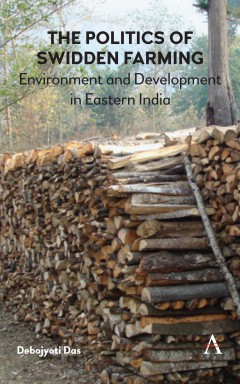The Politics of Swidden farming
Environment and Development in Eastern India
By Debojyoti Das
Other Formats Available:
E-Book- About This Book
- Reviews
- Author Information
- Series
- Table of Contents
- Links
- Podcasts
About This Book
‘The Politics of Swidden farming’ offers a new explanation for the changes taking place in slash-and-burn (jhum or swidden) farming in the highlands of eastern India through an ethnographic case study. Today market-led agriculture is transforming land and labour relations. Jhum cultivators are beneficiaries of state schemes, including internationally funded, community-driven development or biodiversity conservation programmes.
The book traces the story of agroecological change and state intervention to colonial times (including post Indian independence) when Nagaland was seen as the frontier of state and civilization. Contemporary agrarian change can be understood by contextualizing farming not just in terms of the science and technology of agriculture or conservation/biodiversity but also in terms of technologies of rule. For the colonial administrators of the Naga Hills – who saw their role partially in terms of rescue and record ethnography – jhum practices were part of backward Naga customs and traditions. Improving farming practices was bound up with indirect rule as a distinct process of governance involving forms of knowledge and intervention. It was political expediency rather than imperial science that changed local agroecologies and pressurized shifting cultivation. Crucially, neighbouring Naga terrace rice cultivators were promoted as offering a more civilized – yet local – alternative.
‘The Politics of Swidden farming’ demonstrates how contemporary agrarian development reflects this complex colonial heritage, including linkages between the state and village elites. Evangelical missionaries in the post-Independence period also contributed by appropriating local institutions to a Protestant (Baptist) ethic of work. Reinforcing the colonial state’s privileging of rice as the crop of civilization, the missionaries’ moral discourse installed new time disciplines geared to settled agriculture. To this end, the book adds a new dimension to the underdeveloped literature on shifting cultivation in South Asia by focusing on the social ecology of farming and agrarian change in the hills. It provides a comparative viewpoint to state-centred and donor-driven development in the frontier region by bringing in different actors and institutions that become the actants and agents of social change.
Methodologically, the author engages with the many voices that shaped his fieldwork, providing evidence from in-depth household-based participant observation and life histories, and a household survey, while also drawing extensively on original archival research and colonial photography to provide documentation of colonial representations of the swidden landscape. The research was undertaken in a milieu of fear and violence, which raises further methodological and ethical issues.
Reviews
The Politics of Swidden Farming is a solid piece of scholarship. It narrates the long history of the Yimchunger Naga through the prism of jhum, or swidden agriculture. While jhum has historically been dismissed and derided by the powerful as an ‘ignorant and savage-like’ and ecologically destructive form of agriculture – derogatorily also labelled ‘slash and burn’ – Das brings to light how among the Yimchunger Naga it is in fact an evolving and dynamic practice shaped by complex historical, social, and political factors. It is impressively well researched and, as such, amply demonstrates the enduring relevance for scholars of agrarian change of combining rigorous historical work with long-term ethnographic fieldwork. — Kenneth Bo Nielsen, University of Oslo
‘This is one of the best books to date on swidden (jhum) farming. Based on engaged new fieldwork in Northeast India and a rereading of its history, Debojyoti Das gives us an important re-evaluation of agroecology, with global implications, and potential, going far beyond India. His book deserves wide attention.’
—Magnus Fiskesjö, Associate Professor, Department of Anthropology, Cornell University, USA
‘Debojyoti Das’s masterful ethnography and history of Nagaland is an essential landmark. Take an egalitarian population of shifting cultivators at the edge of empire and nation, add the modern state, commodity markets and Baptist “improvement” and you get a “civilizing” revolution that Das examines in remarkable, complex and deeply insightful ways.’
—James C. Scott, Sterling Professor of Political Science and Anthropology, Yale University, USA
‘Swidden cultivation in Northeastern India gets both a fresh and comprehensive treatment in this historical ethnography of villages in Nagaland as it examines how they went from the margins of colonial empire to the edges of the Indian nation-state in the course of the long twentieth century.’
—K. Sivaramakrishnan, Dinakar Singh Professor of India & South Asia Studies, Anthropology, School of Forestry & Environmental Studies, Yale University, USA
‘The Naga are a classic swidden society, beloved by anthropologists and excoriated by government officials [....] Das locates the Naga in space […] and time […] producing a worthy addition to the anthropological literature on swidden societies.’
—Michael R. Dove, Margaret K. Musser Professor of Social Ecology, Yale University, USA
Author Information
Debojyoti Das is an AHRC-GCRF postdoctoral associate at Bristol University, UK. He received his PhD in social anthropology from the School of Oriental and African Studies, University of London, and has held several prestigious fellowships and consultancies at Yale, Sussex and the University of London. Das has published widely in journals such as the European Bulletin of Himalayan Research, Journal of Borderland Studies, Journal of the Indian Ocean Region and Economic and Political Weekly besides contributing to blogs.
Series
Table of Contents
List of Illustrations; Foreword; Acknowledgements; List of Abbreviations; Chapter 1 Introduction; Chapter 2 Methodology and Fieldwork: Negotiating Hazardous Fields; Chapter 3 Ethnography, Violence and Memory: Telling Violence in the Naga Hills; Chapter 4 Jhum and the ‘Science of Empire’: Ecological Discourse, Ethnographic Knowledge and Colonial Mediation; Chapter 5 Land and Land-Based Relations in a Yimchunger Naga Village: From a Book View to a Field View; Chapter 6 The Politics of Time: The Missionary Calendar, the Protestant Ethic and Labour Relations among the Eastern Nagas; Chapter 7 The Micro-Politics of Development Intervention: Village Patrons, Community Participation and the NEPED Project; Chapter 8 Conclusion; Notes, Bibliography; Index.
Links
Stay Updated
Information
Latest Tweets



